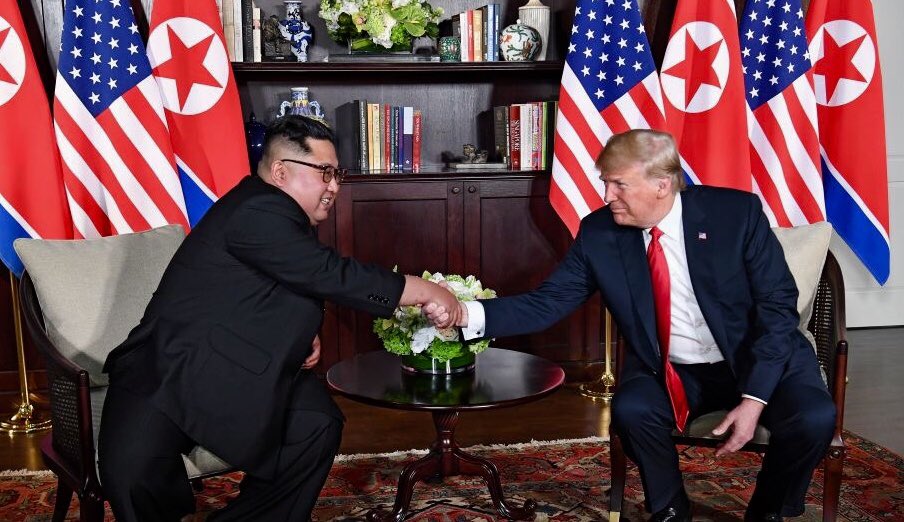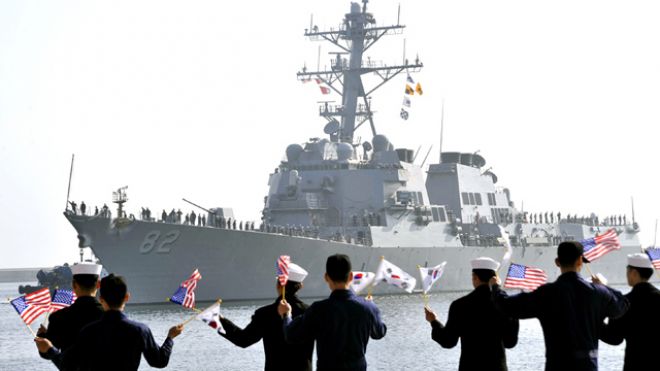According to Gallup’s 2018 annual World Affairs poll, “Fifty-one percent of Americans say North Korea is the greatest U.S. enemy,” followed by Russia with 19%, China with 11%, and Iran with 7%. A poll from Fox News shows that voters favoured President Trump meeting with Kim Jong-un by 63%, but 76% voted that the Democratic People’s Republic of Korea (DPRK or North Korea) will not surrender its nuclear weapons.
But the unique succession of events, shifting from the possibility of nuclear exchange to the first summit between a sitting US president and a North Korean leader in Singapore, could lead to a new level of deterrence or a breakthrough to normalize the state of North Korea for the first time in history.
After the historic, and confusing, summit between President Donald J. Trump and Kim Jong-un in Singapore, Mr. Trump tweeted that North Korea poses no nuclear threat towards the United States of America. According to a Washington Post-ABC News poll, however, the majority of Americans feel that it is too early to tell whether the “U.S.-North Korea summit was a success for either country.” Another poll indicates that many Americas believe “it is unlikely the summit will lead North Korea to give up nuclear weapons” while a different poll reveals that over a half of Americans said, “It was likely the summit will help decrease the nuclear threat.”
In diplomacy, success in promoting any given policy is never assured, especially when dealing with belligerent nations like the DPRK. Nonetheless, the recent summit is considered a major victory for Pyongyang, given how CVID (Complete, Verifiable, Irreversible Denuclearization), which would permanently dismantle North Korea’s nuclear program, was not part of the negotiation, despite offering a protection to Kim’s regime. It was thus disappointing for those who expected complete denuclearization, and not disarmament.
The following points explain how North Korea achieved a victory in the summit:
-
- Solidifying Kim’s Legitimacy: The fact that Kim met with a standing American president for the first time in North Korea’s history—an achievement which neither Kim Jong-il nor Kim il-sung ever accomplished—places Kim Jong-un as equal or greater than of his predecessor. The range of views expressed in public over Kim Jong-un, prior to his succession to power, were unavailable in North Korea since Kim Jong-il passed away quite suddenly without establishing a new version of his predecessor’s cult of personality. Until Kim Jong-un came to power, there was no profusion of approaches to his legacy – only the rapid spread of his involvement in North Korean history, the proliferation of his legacy, and other forms of his historical exhibition were fabricated. The uniqueness of Kim Jong-un’s rise to prominence in relation to his predecessor was the hastily attempt to assimilate the past to present political consciousness, emphasizing Kim Jong-un as a continuing legacy, despite being young and inexperienced, of the Kim dynasty.
-
- Restoration of China-North Korea Relations: The impact of Jang Song Thaek’s execution was of profound concern for Beijing. With 6 nuclear weapons tests, missile launches, and the assassination of Kim Jong-nam, and the fact that North Korea commenced its 3rd nuclear test on February 2013, only a month after Xi Jinping came into power, China took punitive measures regarding the DPRK. For over 5 years, bilateral relations between China and North Korea were limited, especially with the elimination of Jang. In this respect, many have suggested that there has been a split between China and North Korea. Yet as the summit approached, with Kim visiting Xi in China, and Xi providing a Chinese jumbo jet (Boeing 747) for Kim to visit Singapore, a return to diplomatic relations was identified between these two nations—representing restoration and strength of China-North Korea relations and a promise of unwavering friendship.
-
- Termination of “War Games”: The American military apparatus and its presence on the Korean Peninsula are simply not about destroying or hurting the North Korean regime, but rather scaring Kim Jong-un and his loyalists enough to break their spirit. The military exercise, for instance, causes great pressure on North Korea, forcing the North Korean regime to be on a high alert. For North Korea, this causes unnecessary usage of its manpower and resources on already impoverished and derived economy, creating pressure on Kim’s regime. There is also the wider question of ending the Korean War after decades of its armistice. It may seem a little odd, in the context of history, to officially end the war by Mr. Trump who sees no value on the US-Republic of Korea alliance. But an important feature of terminating the war is with respect to the possibility of creating an agreement to reduce or withdraw all United States forces in Korea. Up until recently, Mr. Trump argued constantly that South Korea did not pay enough for American military protection, including the installment of the highly controversial Terminal High Altitude Area Defense, or THAAD. Less than seeing the value of military alliance and the presence of American forces on the Korean Peninsula, the declaration to end the war will provide Mr. Trump with the justification to withdraw American forces in Korea—a goal for the two previous Kims of North Korea, as well as Beijing, have both long sought but failed.
-
- Whitewashed Summit: America and North Korea continue with the complex problem of defining a “partial” denuclearization between the two while struggling with the wider issue of attitudes to the division; America also should consider its relationship with its allies—South Korea and Japan—by ensuring no “passing” occurs. But apart from Mr. Trump’s “business” skills, both South Korea and Japan are left with uncertainty and confusion—an illustration of a pattern from the Vietnam War where America abandoned South Vietnam in exchange for peace—which of course had a laudable result for America by ending the Vietnam War, but did little to preserve the Republic of Vietnam. Although there is a brief transitional phase in which peace is being recognized at this time, what is of note is the development of discussions concerning denuclearization—Mr. Trump announced that an agreement was reached following his statement of having no desire to use ‘maximum pressure’. U.S. Secretary of State Mike Pompeo hopes to achieve a “major disarmament”, but not CVID, unlike the solution advocated for by National Security Adviser John Bolton.
The summit provided a radical divergence in the hopes for an open dialogue in a variety of respects. While it is still unnoticeable to trace any favourable developments for Mr. Trump or South Korea—based on no further news from North Korea yet—one consequence of this summit can prematurely assume that North Korea continues to be quite subversive, and, despite a certain degree of optimism, North Korea has by and largely proven to be notoriously untrustworthy with their pledges.
It is Kim’s desire, most likely, to appear innocent to the world while demanding the international community to acknowledge him as a leader on the world’s stage with a cost: an ultimatum of foreign aid and investment to North Korea in exchange for peace—the very peace which they relinquished with fear. The landmark summit in Singapore, therefore, is either a boldness born of a cause, or a cause to justify Mr. Trump’s risk-taking attempt to seal the Pandora’s box that truly borders madness.
To read Part I of this article, click HERE
Photo: Trump and Kim shaking hands in the summit room, by Shealah Craighead via Trump and Kim shaking hands in the summit room during the DPRK–USA Singapore Summit. Public Domain.
Disclaimer: Any views or opinions expressed in articles are solely those of the authors’ and do not necessarily represent the views of the NATO Association of Canada.




